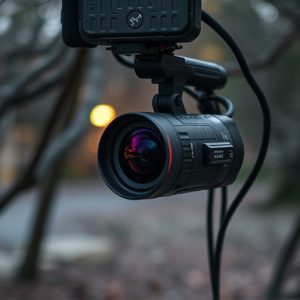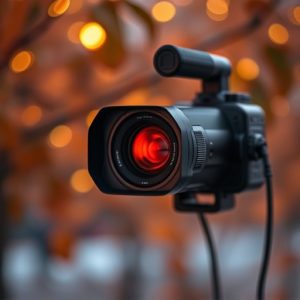Unmasking Hidden Hazards: RF Detector Sweep for Babysitter Surveillance Safety
Hidden cameras disguised as everyday items offer parents remote monitoring of babysitters, providing…….
Hidden cameras disguised as everyday items offer parents remote monitoring of babysitters, providing peace of mind and ensuring safety. RF (Radio Frequency) detector sweeps are effective in detecting these concealed devices by scanning radio signals. A high-quality RF detector covering a broad frequency range (300 MHz – 2.4 GHz) is recommended to accurately identify hidden cameras. Ethical guidelines and legal frameworks regarding privacy rights and consent must be respected when using such monitoring methods.
Uncover hidden cameras with a RF detector sweep—a powerful tool for parents seeking peace of mind while hiring babysitters. This comprehensive guide explores concealed cameras, their potential risks, and how RF technology helps detect them. From understanding the basics of hidden camera types to a detailed step-by-step tutorial on using detectors, we demystify the process. Additionally, ethical considerations and legal guidelines for surveillance ensure responsible practices. Learn how to protect your family’s privacy and make informed decisions regarding babysitter monitoring.
- Understanding Concealed Cameras for Babysitter Monitoring
- The Role of RF Detector Sweep in Uncovering Hidden Cameras
- Step-by-Step Tutorial: Detectors and Detection Techniques
- Ethical Considerations and Legal Guidelines for Surveillance
Understanding Concealed Cameras for Babysitter Monitoring
Hidden cameras, often used for surveillance and security purposes, have become a common tool in modern life—including babysitter monitoring. Concealed cameras for babysitter monitoring allow parents to keep an eye on their children’s caregivers from a distance, ensuring peace of mind. These devices are designed to blend seamlessly into the environment, such as toys, books, or everyday household objects, making them virtually undetectable by the babysitter.
With advanced features like motion detection and real-time video streaming, parents can remotely monitor activities in their homes. This technology empowers parents to verify the safety and well-being of their children while they are at home with a babysitter, fostering trust and transparency between all parties involved.
The Role of RF Detector Sweep in Uncovering Hidden Cameras
The RF (Radio Frequency) detector sweep is a powerful tool in the quest to uncover hidden cameras, especially in situations like babysitter monitoring where Concealed Cameras are a concern. This technology works by scanning and analyzing radio frequency signals, which many modern devices, including hidden cameras, emit. By detecting these signals, the RF detector can pinpoint the exact location of the device, revealing its presence even if it’s cleverly disguised or hidden from plain sight.
In the context of babysitter monitoring, an RF detector sweep allows parents to ensure their children are safe and secure in their care environment. It provides a layer of protection against potential privacy breaches and malicious activities by helping to identify any unauthorized or Concealed Cameras that may be present in the home. This proactive approach ensures peace of mind and reinforces safety measures when it comes to hiring babysitters or leaving children at home alone.
Step-by-Step Tutorial: Detectors and Detection Techniques
Step-by-Step Tutorial: Detectors and Detection Techniques
The first step in detecting concealed cameras, especially for babysitter monitoring, is to understand RF (Radio Frequency) detectors. These devices operate by scanning through various frequencies to pick up signals from hidden cameras that transmit data wirelessly. Start by purchasing a high-quality RF detector capable of detecting a wide range of frequencies commonly used by spy cameras. Next, turn on the device and walk around the area you suspect might contain a hidden camera. The detector will beep or alert you when it detects a signal, indicating the presence of a wireless device nearby.
For accurate detection, it’s crucial to know common frequency bands used in Concealed Cameras for Babysitter Monitoring. Most spy cameras operate on frequencies between 300 MHz and 2.4 GHz. Adjust your detector accordingly to scan within this range. As you move throughout the space, pay close attention to areas where a camera might be hidden—behind pictures, under furniture, or in corners. Remember that some advanced detectors can also pick up infrared signals, adding another layer of protection.
Ethical Considerations and Legal Guidelines for Surveillance
When using RF detectors and sweeping for hidden cameras, especially in scenarios like babysitter monitoring involving concealed cameras, it’s paramount to navigate within ethical boundaries and legal frameworks. The privacy rights of individuals must be respected at all times. In many jurisdictions, there are stringent laws regulating surveillance practices, including requirements for parental or caregiver consent when monitoring children.
Using hidden cameras without explicit permission from the individuals being recorded is a serious breach of privacy and can have severe legal consequences. It’s crucial to familiarize yourself with local laws regarding hidden camera usage, especially in homes or areas where privacy expectations are high. Ethical considerations also involve transparency; informing all parties involved that surveillance is taking place is generally a best practice, fostering trust and ensuring everyone understands their rights.
In conclusion, the RF detector sweep is a powerful tool in the fight against concealed cameras for babysitter monitoring. By understanding the technology behind these devices and employing ethical surveillance practices, parents can ensure their peace of mind while adhering to legal guidelines. This tutorial has provided a comprehensive guide to help you navigate this intricate issue, empowering you to make informed decisions regarding your family’s safety.


